Wicker and rattan furniture have become increasingly popular options for outdoor furniture over the last few decades. However, most people use the terms “wicker” and “rattan” interchangeably, unaware that these words actually refer to two distinctly different materials.
While wicker and rattan pieces may look quite similar at first glance, they have some notable differences when it comes to their composition, durability, maintenance needs, design versatility and pricing. Understanding the unique characteristics of each can help you make a more informed decision when shopping for woven furniture.
In this definitive guide, we’ll unravel the confusion surrounding wicker and rattan, outline the key distinctions between the two, and provide tips on choosing the right option for your needs.
Pros and Cons of Rattan Furniture
| Pros | Cons |
|---|---|
| Natural beauty and texture | Expensive compared to synthetic wicker |
| Extremely durable and long-lasting | Limited to natural color palette |
| Withstands hot and humid climates well | Requires more frequent maintenance |
| Easy to paint and stain to change color | Not seamless to incorporate cushions |
| Develops character over time | Susceptible to moisture damage outdoors |
| Sustainable if harvested responsibly |
Pros and Cons of Wicker Furniture
| Pros | Cons |
|---|---|
| Wide range of style, color, and pattern options | Won’t last as long as natural rattan |
| All-weather synthetic suitable for outdoors | Synthetic fibers may fade over time |
| Generally more budget-friendly | Natural wicker is fragile outdoors |
| Easy to add cushions and pillows | Loose weave can trap dirt and debris |
| Lighter weight than rattan | No natural variations like real rattan |
Wicker vs Rattan Comparison Table
| Category | Wicker | Rattan |
|---|---|---|
| Materials | – Refers to a style of weave, not a specific material – Can be made from natural or synthetic materials like rattan, willow, bamboo, resin, plastic, etc. | – Refers specifically to the stems of rattan palm plants – Natural material only |
| Durability | – Natural wicker is less durable – Synthetic wicker is weather-resistant | – Very durable natural material – Can last 30+ years with care |
| Design | – Wide range of colors/patterns – Contemporary styling options | – Limited to natural wood tones – Traditional, classic styling |
| Texture | – Depends on material – Can feel artificial | – Natural wooden texture – Each piece unique |
| Maintenance | – Synthetic wicker is very affordable – Natural wicker pricier | – Apply protectants – Avoid moisture damage – Lighter cleaning needs |
| Cost | – Synthetic great for outdoors – Natural, better for indoors | – More expensive due to durability and natural materials – Premium prices |
| Best Use | – Natural wicker less durable – Synthetic wicker is weather-resistant | – Works well both indoors and outdoors – Best for patio and poolside |
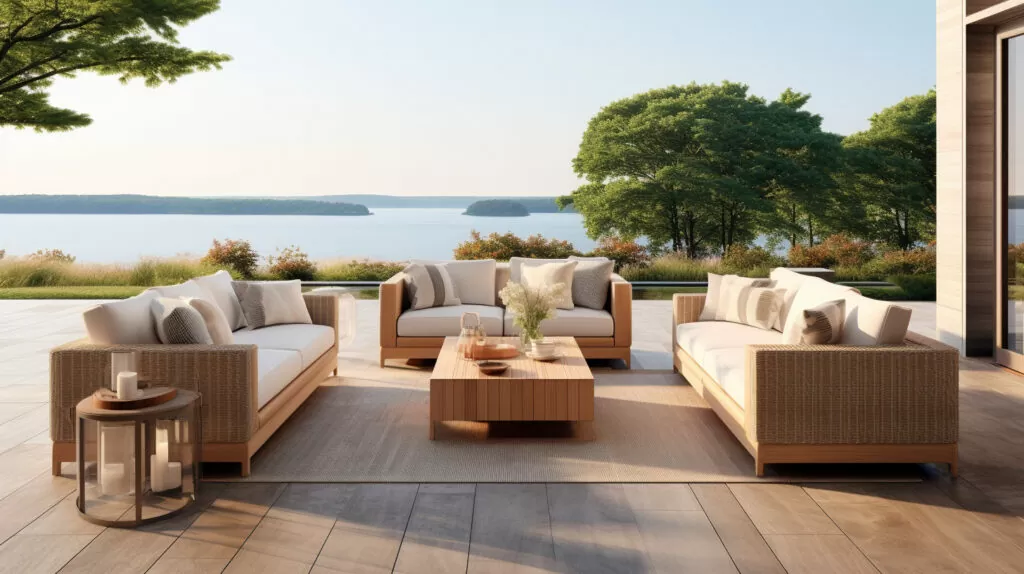
What is Wicker?
Wicker refers to a specific style of weaving that creates a lattice-like pattern, typically used for baskets, furniture and other accessories. The term “wicker” itself simply describes the woven style, rather than referring to any particular material.
Wicker weaving dates back thousands of years, with evidence of its use found in Ancient Egyptian tombs and even in the writings of Roman scholar Pliny the Elder. While originating in Europe, wicker really gained widespread popularity during the Victorian Era. Today, you can find wicker furniture and accents all around the world.
When it comes to wicker furniture, the “wicker” descriptor refers to the crisscross weaving pattern, but the actual material used to create that lattice-work design can vary:
- Rattan wicker – Rattan cane is one of the most common materials used in traditional wicker weaving, which we will explore further in the rattan section below. Natural rattan has a bowed shape that lends itself well to curving, shaping and weaving.
- Reed wicker – Reed is another natural material often used for weaving wicker furniture and accessories. Reed has solid, cylindrical stems similar to rattan but generally has a more rigid texture and reddish-brown color.
- Willow wicker – Willow branches have long been used to create lightweight wicker baskets and furniture. Willow has more flexibility than reed but less natural curvature than rattan.
- Bamboo wicker – Bamboo is a grass material that can be woven into furniture and accessories with a wicker style. It has a naturally smooth, cylindrical shape ideal for weaving.
- Synthetic wicker – Also known as “all-weather wicker”, synthetic fibers woven into a wicker pattern are now commonly used for outdoor patio furniture that can withstand the elements. Materials like plastic, resin, and vinyl are shaped and woven to emulate natural wicker’s look and feel.
In summary, wicker refers specifically to the woven style, while the actual material used to create that signature crisscross lattice pattern can vary. Natural wicker utilizes materials like rattan, willow, reed, and bamboo, while synthetic wicker uses man-made materials for increased durability outdoors. Read more if you’re curious about different wicker types:
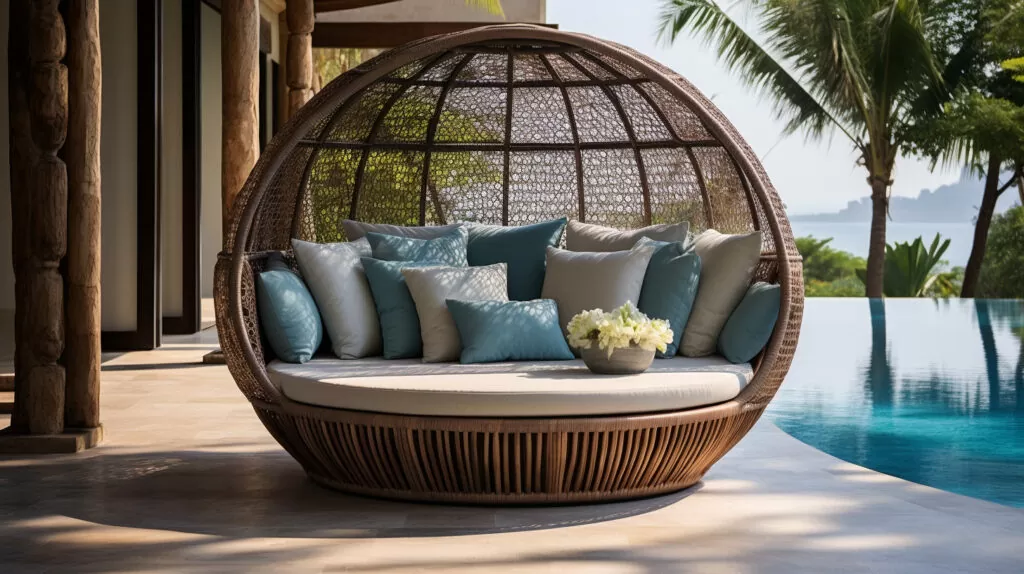
What is Rattan?
Unlike wicker, rattan is not a general term for a style of weaving, instead, it refers specifically to the thin, solid stems of a particular species of palm tree native to tropical regions of Africa, Asia, and Australia.
Rattan palms are vining plants that can grow up to several hundred feet long, climbing up trees and other structures in the rainforest. The long, flexible stems of the rattan palm are harvested, stripped of their outer bark, and used to create woven furniture, baskets, mats, and other household goods.
There are over 600 species of rattan palm, but only about 13 are used commercially for wicker furniture manufacturing. Some of the most commonly used types include:
- Malacca rattan – Pale yellow in color, Malacca is one of the strongest rattan varieties, known for its durability. It has smooth surfaces that accept paint and stain well.
- Manau rattan – Manau has a reddish-brown hue when harvested, darkening over time. It has a coarse texture and good flexibility.
- Bakau rattan – Bakau has yellowish-white stems and is among the most widely used rattan for furniture weaving. It is flexible and accepts paint and finishes nicely.
- Lao rattan – This type of rattan has a smooth texture and small diameter size. It has a light yellow color and good tensile strength.
- Red rattan – As its name suggests, red rattan has a reddish coloration. It is not quite as strong as other varieties but is lightweight and weaves smoothly.
Rattan’s innate strength, flexibility, and ramrod straight shape when the outer bark is removed make it an ideal natural material for weaving and shaping into furniture. As we will explore later, its durability and natural beauty are among the primary benefits of rattan furniture.
Key Differences Between Wicker and Rattan
Now that we’ve defined what wicker and rattan each represent individually, let’s look at some of the key differences between the two:
Wicker Refers to a Weaving Style, Rattan is a Plant Material
This is the single most significant difference that sets wicker and rattan apart. Wicker describes a method of crisscross weaving that creates a lattice pattern. Rattan is the name for the solid stems of palm trees used as a material.
You can have rattan wicker furniture, which uses rattan stems woven in a wicker style, but wicker furniture itself can be made from many different materials beyond just rattan.
Rattan has Natural Origins, Wicker Can Be Synthetic
Rattan specifically refers to the stems of rattan palms, it is an organic, natural material. Wicker is a broad term referring to a woven pattern and nowadays is usually made of synthetic materials.
All-weather wicker furniture for outdoor use is typically made of synthetic materials like plastic, resin, or vinyl, woven to emulate the look of natural wicker. Synthetic fibers are more resistant to weather, moisture, and UV damage than natural wicker.
Rattan Offers Consistent Texture, Wicker Texture Can Vary
The texture and feel of an all-rattan piece will be fairly consistent throughout since it comes from a single source material. Wicker furniture, on the other hand, can have variations in texture depending on the material used to create the weave.
For example, reed wicker may feel coarser and stiffer than rattan wicker. Synthetic wicker could have an overly uniform, manufactured look compared to natural wicker materials.
Rattan has Limited Color Variation, Wicker Offers More Choices
Since most rattan stems have a natural tan, brown, or black colored bark, the color palette is limited to mainly natural wood tones. Of course there can be some variation between species, for example, red rattan has a reddish hue, while Malacca rattan is more pale.
With synthetic wicker, the color choices become almost endless! Synthetic wicker fibers can be produced in bright whites, bold colors, or modern black hues, which is not possible with natural rattan or other natural wicker materials.
Rattan Offers Distinct Natural Beauty, Wicker Can Appear More Uniform
One of the distinct appeals of rattan is its inherent natural beauty as an organic material. Each piece will be unique with slight variations in color, grain and texture. There is often a pleasing flow and curvature to the rattan stems used in weaving.
The man-made materials give the weave a more manufactured appearance versus natural wicker’s rustic character. Wicker made from uniform synthetic fibers do lack some of the visual charm and appeal of natural rattan.
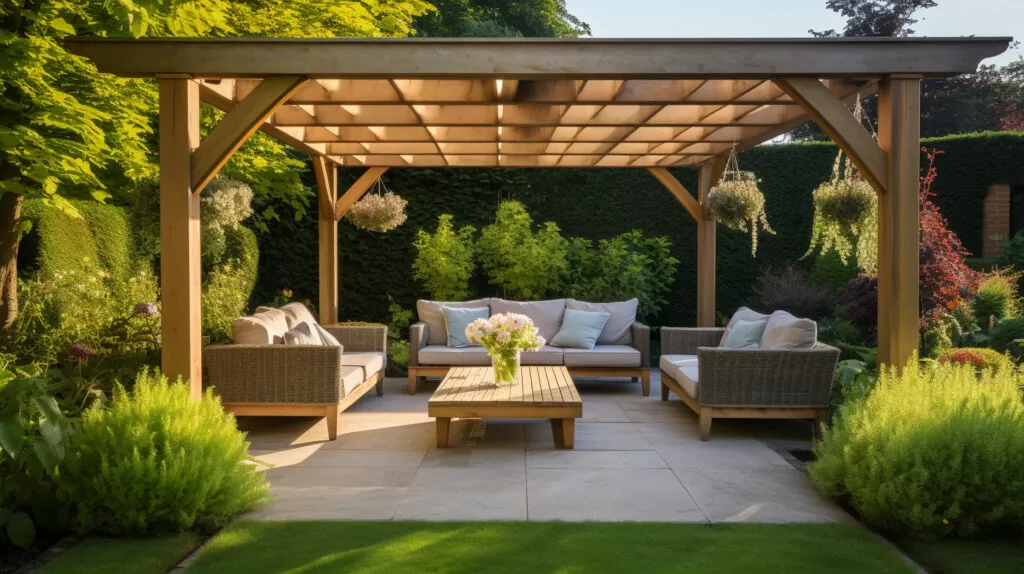
Durability and Longevity: How Long Does Wicker and Rattan Furniture Last?
A major factor to consider when choosing between wicker and rattan is the expected lifespan. Let’s take a look at the durability and longevity you can expect from each:
Rattan Furniture Lifespan
Well-made rattan furniture that receives proper care both indoors and outdoors can last 10-30 years. High-quality, closely woven, rattan pieces or rattan used in combination with sturdier frames could last upwards of 40-50 years before needing replacement.
Indoors, rattan will typically outlast the fabric and cushions used on the piece. Outdoors, direct sun exposure and moisture will impact rattan’s lifespan, but a well-crafted rattan patio set with proper maintenance should still get a decade or more of use.
Wicker Furniture Lifespan
For wicker pieces made from natural materials like willow, bamboo, or thinner reed, the average lifespan is approximately 5-15 years with proper care and maintenance. These less sturdy, natural wicker materials are best used indoors.
Synthetic all-weather wicker lasts considerably longer, up to 10-20 years, and it holds up better than natural wicker when left uncovered outdoors. With direct sun exposure, regular maintenance is still needed for maximum longevity of synthetic wicker.
In summary, rattan will generally outlast natural wicker, while synthetic wicker has greater durability than both natural wicker and rattan when used outdoors. Investing in high-quality materials and construction, will help maximize the lifespan of either option.
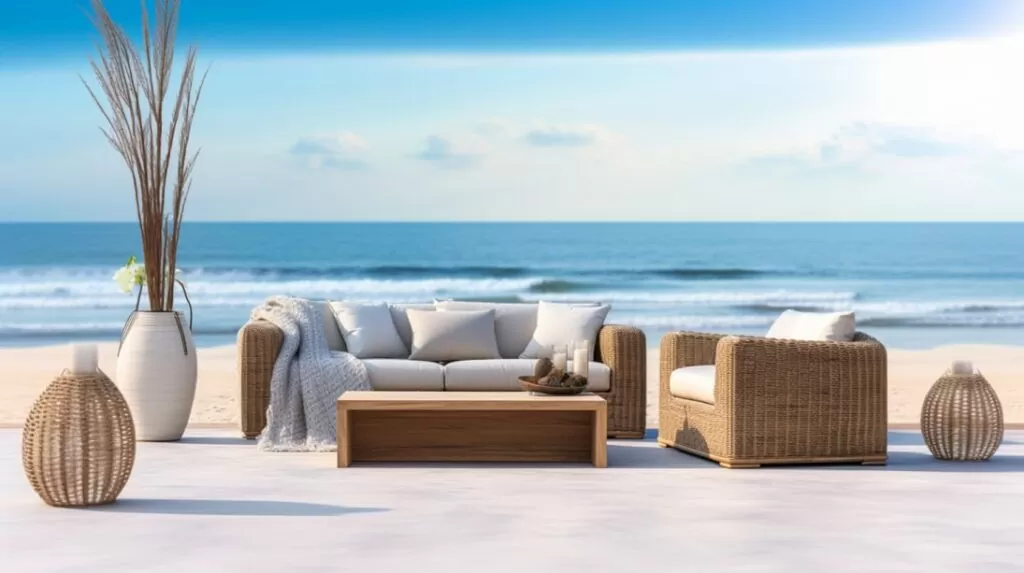
Maintenance and Care: Keeping Wicker and Rattan Furniture Looking Its Best
To get the most enjoyment and lifespan from your woven furniture, performing proper routine maintenance is essential. Let’s look at some wicker and rattan furniture care tips:
Rattan Furniture Maintenance
- Regular dusting – Dust rattan frequently to prevent the buildup of dirt, grime and debris that can lead to staining or damage over time. Use a duster or dry cloth.
- Spot clean spills – Immediately wipe up any food, drink, or other spills to prevent staining. Use mild soap and water, then dry thoroughly.
- Apply protectants – Use formulations specifically made for rattan furniture to protect the finish from moisture, UV rays, and damage from other sources. Re-apply 1-2 times per year.
- Avoid harsh chemicals – Do not use abrasive cleaners, bleach, or other harsh chemicals. They may damage the rattan fibers or applied finish. A gentle dish soap solution is ideal for cleaning.
- Monitor for damage – Periodically inspect joints, weaving, and the rattan frame for any signs of damage. Little issues can become bigger problems if not addressed promptly.
- Deep clean annually – More involved annual cleaning keeps rattan looking its best. Wipe down all surfaces with a mild soap solution. Rinse and let dry completely before re-applying the protectant.
Wicker Furniture Maintenance
- Vacuum regularly – Use crevice tools and brush attachments to remove dirt and debris trapped in the weave.
- Rinse with hose – For outdoor wicker, occasionally hose down to rinse away stuck-on dirt, grime, and environmental contaminants. Allow to fully dry.
- Spot clean – Immediately clean spills with a damp cloth. For tougher stains on vinyl wicker, use a mild detergent.
- Apply protectant – Protect outdoor wicker from UV rays with an all-weather guard formula. Re-apply every 6 months.
- Avoid harsh chemicals – Do not use abrasives or bleach, which can damage the woven material.
- Inspect for damage – Look for loose weaving, broken pieces, or cracks and repair right away.
- Deep clean seasonally – Thoroughly clean woven crevices with an all-purpose cleaner to restore beauty.
With the proper routine maintenance, both rattan and wicker can look fresh for many years to come. Explore further if you’re interested in learning more about how to store wicker furniture properly:
- How to Properly Store Wicker Patio Furniture in the Winter
- How To Repair and Restore Wicker Furniture
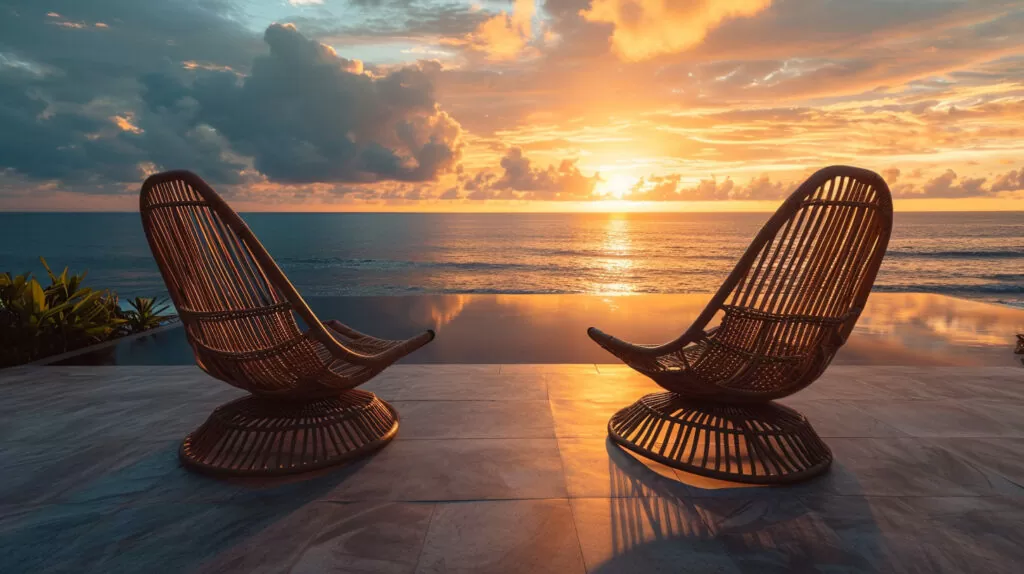
To wrap things up
Rattan and wicker may appear similar at first glance, but they have distinct differences when it comes to materials, manufacturing, durability, design, pricing and maintenance needs.
Rattan offers unrivaled longevity, classic styling, and natural beauty as a material. Wicker provides abundant options for colors, patterns, and synthetic weather resistance as a woven style.
Understanding these key distinctions will help guide you in selecting the right woven furniture to meet your needs and design vision. Check here if you’re looking for an outdoor wicker furniture buyer’s guide. With some smart shopping, both rattan and wicker can add elegance, comfort, and visual interest to your living spaces.
Patio Productions is an online retailer of chic outdoor furniture ranging from outdoor day beds to bar sets. You can browse a variety of collections and styles of wicker furniture by Visiting Our Homepage. All orders are carefully packaged before being shipped to you FREE of charge!

Cheryl is an award-winning landscape design consultant in San Diego, CA. She has over a decade of experience in the design world, working on both interior and exterior projects. She received her certification in design in 2010 and has contributed to the design of 7 separate furniture collections. Cheryl began lending her expertise to Patio Productions’ blog in 2012. When she’s not living in the furniture and design world, she’s busy playing with her dogs at home, or curling up with a cup of black coffee and a beautiful book on modern design. Her favorite patio furniture are her Acapulco Chairs in lightning blue.

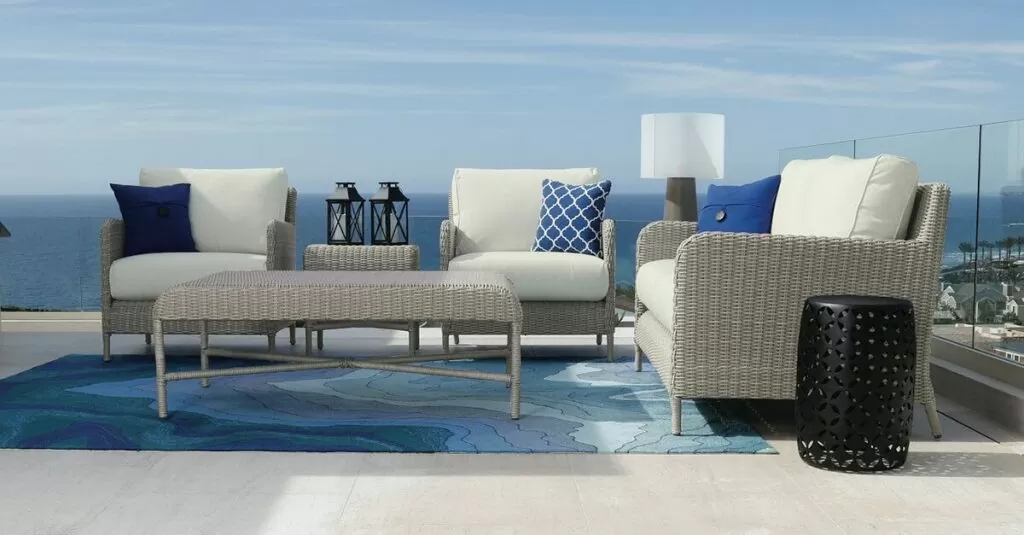

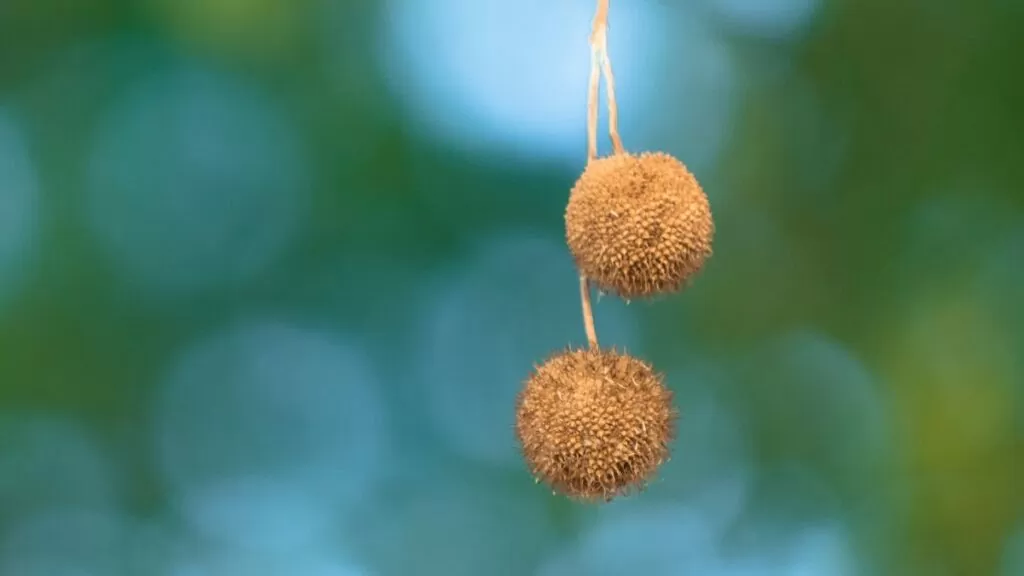



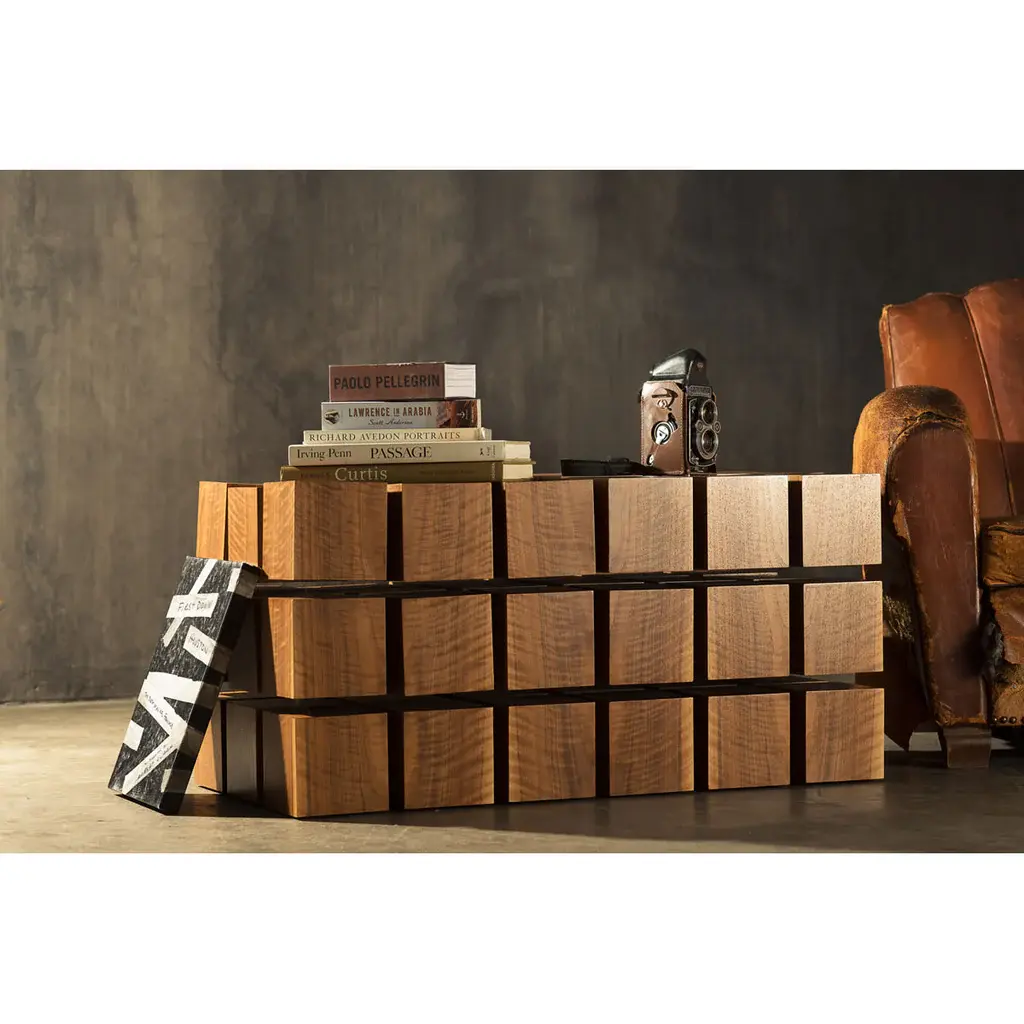

Pingback: Natural Wicker vs Synthetic Resin Wicker
Pingback: Can You Use Wicker Furniture Outside?
Pingback: HDPE vs PVC Wicker: What's the Difference?
Pingback: The Best Outdoor Wicker Furniture Brands
Pingback: Thick Wicker Furniture Sets with Rounded Strands